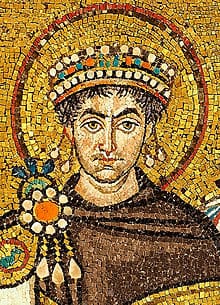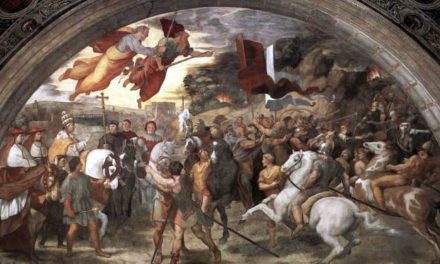Let’s get ready to rumble!
Well–It’s not exactly a rumble we’re in for in this episode, so much as a tumble into the rabbit hole of theological wrangling that took place after the Council of Chalcedon that led to the 2nd & 3rd Councils at Constantinople in 553 & 680.
And it all comes back to the debate fired up between Cyril & Nestorius over how to understand the natures and person of Christ.
“Wait!” you say. “Didn’t the last Council at Chalcedon clear all that up?”
We thought so. But large groups weren’t happy with the conclusions of Chalcedon. They said the wording of the Creed was too Nestorian. They claimed Cyril’s formulations that had been accepted at the Council of Ephesus didn’t figure strongly enough in the work done at Chalcedon and wanted the orthodox statement on the nature of Jesus amended along more Cyrillian lines.
It must also be said that by the beginning of the 6th C, the Nestorian Church of the East & centered in Persia, had by this time gone well beyond the actual position of Nestorius into the idea that Jesus was indeed, not just of two natures, but He was two persons; one divine, the other human. We’ll not broach the intricacies of that theology since it takes us on a tangent, and with my ineptitude, would only confuse us all anyway. The upshot is, the Orthodox Churches of East & West had already drawn a line over which they’d set the Nestorian Church of the East as heretics. It’s no wonder then that the Nestorians rejected both the Councils of Ephesus and Chalcedon.
But it wasn’t just the Nestorians who rejected Chalcedon. A growing number of groups along the Mediterranean coast in Syria, Egypt, Palestine, then inland in Armenia also rejected Chalcedon. These groups were uniformly Monophysites, that is, they believed Jesus possessed single nature, as opposed to the dual-nature proscribed at Chalcedon. But there were different groups of monophysites. That is, they arrived at their monophysitism via different routes.
Those following Cyril said that Jesus did indeed have two natures as God & Man, but that His deity utterly overwhelmed His humanity. Another group followed the ideas of the now officially declared heretic Eutyches and said Jesus did indeed TECHNICALLY have two natures, but that they’d fused together into a new, third nature that was a perfect union of human and divine. They preferred to refer to this not as mono-physitism, but as mia-physitism.
So, the Church was thus split in 3 segments; the Nestorians in the East, outside the Empire, and the Chalcedonians & Non-Chalcedonian Monophysite sharing the Empire. The Second Council at Constantinople was an attempt to reconcile the Chalcedonians and the Monophysites by once more condemning Nestorius and putting the language of Chalcedon in more palatable terms for the Monophysites.
Before we get to the Council, we need to talk a bit about some writings that had been making the rounds called the Three Chapters. In 551, 2 years before he called the Second Council of Constantinople, the Emperor Justinian issued an edict condemning a collection of writings from 3 sources which collectively supported what Nestorius had really taught about the nature of Christ, rather than the misrepresentation of his critics, as well as a thorough examination of Cyril’s Christology, revealing its tendency toward monophysitism. The Three Chapters was keeping the whole Christological controversy alive and calling into question the validity of both the Councils of Ephesus and Chalcedon, so Justinian decided to shut it down by passing an edict condemning the Three Chapters.
But you know what happens when the man at the tope tells people not to read or heed something, right? Yep – it only makes more people curious. And the more that read The Three Chapters, the more were worried the Councils may have erred.
So Justinian called a new ecumenical council for May of 553, hoping to reconcile the recalcitrant Monophysites with the Chalcedonians by making clear his dismissal of Nestorianism.
The Council was presided over by the Patriarch of Constantinople, one Eutychius. Pope Vigilius was invited and as circumstance would have it, he was in the City at the time, due to having fled there for refuge from the rampage Ostrogoths in his native Italy. But Vigilius declined and issued a statement forbidding the Council proceeding without his authorization. The other bishops ignored him and went ahead. They condemned the Three Chapters, and in the 7th session, had Pope Vigilius’ name stricken from the diptych, that is, the official list of names with whom the bishops recognized as in fellowship with them. BY this action, they excommunicated the Pope for his refusal to appear at the Council. Vigilius was then imprisoned in the Capital by Justinian, his advisors exiled. 6 Months later, Vigilius agreed to condemn the Three Chapters, claiming he’d been misled by those now exiled advisors. He then approved the Council’s work.
The Council had hammered out a compromise they thought would uphold Chalcedon while ameliorating Monophysite concerns Cyril’s theology had been discarded. The Council showed great deference to Cyril’s ideas and cited his arguments as definitive in their Christological concerns. In several places they deliberately mention Christ as a single person, condemning those who want to cast Christ’s two natures in two persons, an obvious jab at the Nestorian Church.
The Council’s stated regard for Cyril’s theology moves some historians to believe this Council was really a counter by Monophysites meaning to undo Chalcedon. That’s probably not warranted since the creed this Council produced reinforced Chalcedon’s ideas. None of its adopted Cyrillianisms interfere with the language of Chalcedon.
And if this Council was an attempt at reconciliation, it failed. Monophysites rejected BOTH Chalcedon and this Second Counsel of Constantinople. To this day, the Syriac, Armenian, and Coptic Orthodox churches continue that tradition. The theological rift morphed into a political breach when these regions refused to honor the rule from the Eastern Capital. They were then subsumed under the Islamic Caliphate a century later.
When news of the Council’s treatment of the Pope, and its refined Creed reached the Western Churches, many dioceses rejected it and only came to a begrudged acceptance after a century or two.
All that brings us to the 6th Ecumenical Council, which was also held in Constantinople a hundred and thirty yrs later.
Because the Chalcedonians—Monophysites rift wasn’t sealed, a new idea about the nature of Christ was proposed. This time it dealt with Jesus’ will, or wills. The questions asked was, “If Jesus is One Person with two separate & distinct natures, as Chalcedon said and the last Council affirmed, then how many wills does He have; one or two?” One group came out with a resounding insistence Jesus had a single will. This was called Monothelitism.
Monothelitism came from the Monophysite camp, saying it was only Christ’s divine will that was active in the Incarnation. He still had a human will, but it was dormant, inactive; in a kind of spiritual hibernation. Adherents to this doctrine hoped it would prove an end to the long running controversy over the natures of Jesus. Christ retained two natures and two wills, but the human was subordinated to His divine. For Monotheliticists, there was no question about how Christ experienced his life in the Incarnation as a person. This doctrine was promoted by Sergius and a group of dedicated theologians. It had the enthusiastic backing of Emperor Heraclius, who hoped it was a way to mend the breach between Chalcedonians and Monophysites.
This issue of how many wills Jesus had may be one of the most obscure debates in Church history. As we’ve seen in previous episodes, early church fathers were concerned that if Christ was not completely human, humanity couldn’t be completely redeemed. Monothelitists said Christ was completely human, but that his divine will had taken over such human tasks as eating, drinking, and other activities that engaged the physical realm.
Set over against the Monothelitists were the, ready for another tongue-twister? The Dyothelites, who said Jesus had two co-equal wills, one human the other divine. They aregued that it’s pointless to say Jesus was fully human, but then to gut Him of one of the priome characteristics that makes a human, human, and not a mere animal – the will, the power to make real moral choices. The dyothelites were led by a theologian named Maximus. He said the divine and human wills of Jesus worked in concert; the human submitted to the divine, but not at all subsumed in some kind of dormant state. It was every bit as active as the divine will, but was in total submission to it, as the faithful & obedient believer ought to submit to the will of God.
Maximus was concerned to address an issue the Monothelites had raised; that two wills would mean an internal conflict in Jesus that would be difficult to resolve. Maximus said there was no reason to assume Jesus’ human will would be at odds with the divine, since He was without sin. Indeed, the Gospels repeatedly convey the idea of the human will of Jesus submitting to the divine. All this means that Jesus embraced the fullness of our humanity. He held nothing at bay in His experience of being human and taking our place. So when He died, it accomplished our complete salvation.
20 years after Maximus was martyred by a pro-monothelite Emperor, the 3rd Council of Constantinople adopted his position and the cooperation of the Jesus’ dual wills like this. The Creed says, “His human will was lifted up by the omnipotency of his divinity, and his divine will was revealed to men through his humanity.”
One writer describes the important difference between the one and two will positions like this . . .
Pyrrhus was a monothelite. Maximus, as we’ve seen was the leading dyothelite.
Regarding Christ’s suffering in Gethsemane, Pyrrhus said Jesus’ asking the Father to take the cup from Him was really just giving expression that what a human nature that loves life and does not want to die would say. But Christ wasn’t really asking the Father to spare him the cross, since that would mean He was willing something the Father didn’t. Instead, he simply empathized with how one of us would feel in that situation.
Maximus argued Christ genuinely wrestled with the question of dying, but redeemed our disobedience in Eden by making his human will obedient to the point of death.
Pyrrhus’s position may appear to resolve some difficulties with reconciling Christ’s divinity & humanity, but only by making, the Incarnation a kind of sham, where The Eternal Son takes on an only pseudo-human experience, like He’s acting out a part, rather than becoming it.
We have one Council left to cover. The Seventh and final Ecumenical Council takes us back to where it started, Nicaea, but 450 years after the first.





